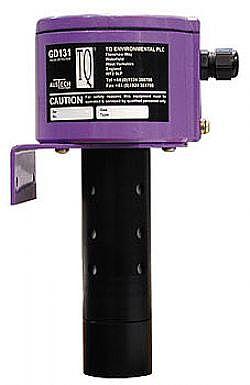IN today’s business environment cost saving is becoming paramount and there is no better example than in the refrigeration industry.
Small long term leaks of expensive refrigerant is costing businesses dearly in terms of recharging or repairing systems after small long term leaks gradually reduce the efficiency of the plant and increase the energy requirement to maintain the cooling capacity. These expensive leaks mean that refrigerant systems are not working to their required efficiency levels and are consuming additional power.
Whether it be a supermarket or an office block air conditioning system organizations are losing money as expensive refrigerant slowly leaks out over long periods of time at very low concentration levels.
In the past technology has been employed to detect spills of gas. These gas leaks tend to be measured in terms of volume of gas and occur rapidly and discharge the gas rapidly. But the technology could never address the underlying problem of low level long term leaks.
The way forward
The refrigeration industry is going through a change and manufacturers are being asked to develop more environmental friendly and cost effective ways to use refrigerants. Refrigerant users are starting to help themselves by fitting refrigerant gas detection systems that detect these very low levels of concentration of gas.
The idea behind the system is to alert the user to a leakage of refrigerant gas as soon as possible at very low levels of concentration. This has two advantages. Firstly, the financial benefit, ensuring that expensive refrigerant gas is not being lost and also that the system does not have to work harder to service the cooling capacity due to there being less refrigerant gas in the system. Secondly, of course, is the environmental benefit of ensuring that fluorinated gases are not escaping into the atmosphere.
It is all very well having a refrigerant leak detection system, but it’s no good finding out that a leak has occurred once a large volume of refrigerant gas has been lost.
The answer is to employ a TQ Infra Red refrigerant gas detection system that detects the leakage before it causes a problem.
Infra-red Non Dispersive Techniques (NDIR) have been around for years but pioneering work by TQ Environmental Technologies has enabled the design of robust cost effective equipment and sensors specifically for use in the refrigeration industry to detect very low levels of gas (ppm). The sensors detect right down to 20ppm (% volume of gas = 10,000ppm) to alert the user to a gas leak as soon as possible before the gas leak becomes a serious problem.
Some gases including all HCFC, CFC and the newer composite gases absorb infra-red energy; these energy levels are very small and are confined to specific wave lengths in the infra spectrum (around 3-10 micro meters).
By monitoring the absorption of infra-red energy at specific wavelengths over a predefined path length and using state of the art microelectronic techniques, it is now possible to provide a very accurate, reliable and repeatable method of measuring low levels of leakage of refrigerant gases – detecting the leakage of the gas before efficiency is lost and power consumption increases.
Earlier technologies were not suitable for this low level of detection as they were prone to cross sensitivities of other vapors or gases found in plant rooms. They often gave false alarms and drifted with variations in temperature and humidity.
The TQ Infra-red sensors are immune to changes in humidity, temperature and are specific to the targeted gas. The sensor is also more reliable, is not prone to false alarms and requires infrequent calibration once factory set.
The TQ131 is an individual single point infra-red sensor which is calibrated to detect a specific refrigerant gas such as R134a, 123, and 407c. The sensor detects gas in the range of 0-4000ppm and a 4-20mA linear output, and is powered from 24VDC. It is factory calibrated and can interface to any controller/PLC which can provide 24V@0.5A.
The 4-20mA can drive into loads up to 1k Ohm, while the sensor/controller interface is a three-wire screened cable and can be situated up to 1000 metres apart.
The TQ4200 employs just one infra-red sensor but actually pulls the gas sequentially from up to 16 sampling points, the sampling points are reached using narrow bore tubing which is very easy to install.
The 4200 uses the state of the art GD137 infra-red refrigerant gas sensor, which is factory set to any four refrigerant gas types (typically R22; R134; R123; R404; R407; and R422) in the range 0-250ppm with selectable alarm set points from 20ppm. Other gas types can be factory set as required.
Each line can be user adapted for the period of sampling and the gas type on the line along with the alarm threshold. The system is also MODBUS enabled, allowing it to interface to hierarchal systems. The power connection is straight forward via 110 or 240VAC. The sample lines are connected directly the unit and there are relays (volt free contacts for alarms).






